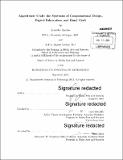| dc.contributor.advisor | Leah Buechley. | en_US |
| dc.contributor.author | Jacobs, Jennifer (Jennifer Mary) | en_US |
| dc.contributor.other | Massachusetts Institute of Technology. Department of Architecture. Program in Media Arts and Sciences. | en_US |
| dc.date.accessioned | 2014-11-24T18:39:13Z | |
| dc.date.available | 2014-11-24T18:39:13Z | |
| dc.date.copyright | 2013 | en_US |
| dc.date.issued | 2013 | en_US |
| dc.identifier.uri | http://hdl.handle.net/1721.1/91843 | |
| dc.description | Thesis: S.M., Massachusetts Institute of Technology, School of Architecture and Planning, Program in Media Arts and Sciences, 2013. | en_US |
| dc.description | 49 | en_US |
| dc.description | Title as it appears in the MIT degrees awarded booklet, September 18, 2013: Algorithmic craft: tools and practices for creating useful and decorative objects with code Cataloged from PDF version of thesis. | en_US |
| dc.description | Includes bibliographical references (pages 129-131). | en_US |
| dc.description.abstract | Programing is a singular creative tool with the potential to support personal expression. Unfortunately, many people who are new to programing view it as a highly specialized, difficult and inaccessible skill that is only relevant for career paths in science, engineering, or business fields. Despite this perception, programing enables novel forms of creative expression and communication in the medium of computation. Visual and physical art, craft, and design are interrelated domains that offer exciting possibilities when extended by computation. By forging strong connections between the skill of programming and the construction of personally relevant physical objects, it may be possible to foster meaningful creative experiences in computation and making for non-professionals. The combination of computational design, digital fabrication, and hand craft to create functional artifacts offers an opportunity to make programing compelling for people with an interest in craft sensitive forms of making. I define the synthesis of these fields with the term algorithmic craft. This thesis describes my work in developing a set of software tools that attempt to make the practice of algorithmic craft accessible for novice programers. Through it, I describe the design of each tool and discuss my experiences in engaging people in the creation of objects that are imagined by the mind, designed with programming, formed by machines, and shaped by hand. | en_US |
| dc.description.statementofresponsibility | by Jennifer Jacobs. | en_US |
| dc.format.extent | 131 pages | en_US |
| dc.language.iso | eng | en_US |
| dc.publisher | Massachusetts Institute of Technology | en_US |
| dc.rights | M.I.T. theses are protected by copyright. They may be viewed from this source for any purpose, but reproduction or distribution in any format is prohibited without written permission. See provided URL for inquiries about permission. | en_US |
| dc.rights.uri | http://dspace.mit.edu/handle/1721.1/7582 | en_US |
| dc.subject | Architecture. Program in Media Arts and Sciences. | en_US |
| dc.title | Algorithmic craft : the synthesis of computational design, digital fabrication, and hand craft | en_US |
| dc.title.alternative | Algorithmic craft : tools and practices for creating useful and decorative objects with code | en_US |
| dc.title.alternative | Synthesis of computational design, digital fabrication, and hand craft | en_US |
| dc.type | Thesis | en_US |
| dc.description.degree | S.M. | en_US |
| dc.contributor.department | Program in Media Arts and Sciences (Massachusetts Institute of Technology) | |
| dc.identifier.oclc | 894245026 | en_US |
